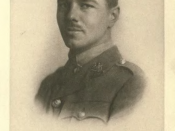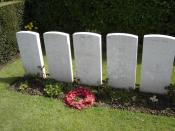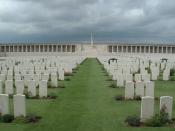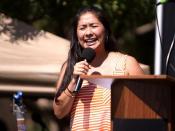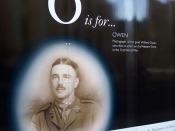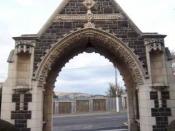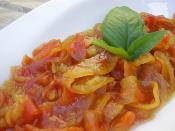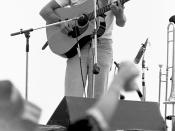Good Morning Year Twelves. As you know, you have been studying poetry over the past term and I am here today to present you a seminar entitled, "Poetry - Changing Times, Changing Ideologies. Our society has forever valued poetry as part of our cultural heritage, but what is poetry? Well poets have written on every possible theme and in every form. There are as many definitions of poetry as there are poets. One definition of poetry is any imaginative awareness of experience expressed through meaning, sound, and rhythmic language choices so as to evoke an emotional response.
Throughout this seminar I will be focusing on a topic that has been a part of our society since the dawn of mankind. War. A contest between nations or states, carried on by force, whether for defense, for revenging insults and redressing wrongs, for the extension of commerce, for the acquisition of territory, or for any other purpose.
War has plagued us as a human race. There is not one generation in mankind that can say that world peace existed throughout their entire lifetime.
There are countless songs and poems that tell tales of war from millennia ago till now. I have chosen two poems to analyze for you today. Dulce et Decorum Est by Wilfred Owen and the song, I Feel Like I'm Fixing to Die Rag by Country Joe and the Fish.
I believe that these two texts are of the finest artworks of their time, simply because the brilliant use of the poetic devices used by Owen and McDonald were successful in spreading their views to the public.
**Poem 1**Dulce et Decorum Est Pro Patria Mori, meaning, it is sweet and fitting to die for ones country. What does it mean to die for your country? Does it generate glory and honour? Is it really beautiful to die in battle? Wilfred Owen tells the truth behind this phrase in his poem, Dulce et Decorum Est.
Born in 1893, Wilfred Owen was an English poet and soldier regarded by many as one of the leading poets of the First World War. His shocking, realistic war poetry on the horrors of trenches and gas warfare were heavily controversial as they sat in severe contrast to the public's perception of war at the time. In the First World War, the public saw it as their duty to protect their country from the enemy and that losing their life in battle for their country was an honorific notion.
Dulce et Decorum Est is a poem about a soldier based at a trench, in the First World War. It is written in the first person from the perspective of the soldier. The poem tells of the true conditions that soldiers must endure for their country. The view that Owen puts fourth, that fighting for ones country is completely opposite to the general perception of the public, is the focus in the text and the terrible use of gas warfare is used to help promote this view.
The tone of the poem is morbid and intense as the soldier retells the events that he witnesses on the battlefield, with the mood changing to realisation in the last stanza as the reader becomes aware that the common perception of war is inaccurate.
Owen uses an original structure in his poem where the 1st and 3rd lines and the 2nd and 4th lines of every four lines rhyme. It continues in this pattern like so for a total of 28 lines. *(read powerpoint, ababcdcd)*. This sort of experimentation with form and meter was very common at the time as poets were in a rapidly changing world. This structure gives the poem a sense of repetition, which corresponds with the 1st stanza where it tells of the exhaustion of the soldiers and how the fighting keeps going on and on and on. The structure gives us a realistic rhythm where in the first stanza it is slow paced because of the tired soldiers and in the second stanza it suddenly becomes a quick pace because of the hurry to put gas masks on.
Owen uses a range of vivid and well thought out vocabulary to get us to visualise what the soldier is witnessing. The language in the poem is used successfully because the poet describes the events that take place so well in such a limited number of lines.
The poem has a discourse of death, which is promoted by words like "coughing like hags", "guttering, choking, drowning", "froth corrupted lungs" and "obscene as cancer" to name a few. Words like these invite the reader to sympathise and grieve for the soldiers and as intense graphic scenes are thrown at them, the reader becomes more in touch with the soldier.
The imagery that is used in this poem creates such strong mental images. The first stanza gives us a strong imagery of how tired the soldiers were with words like, "trudge", "limped on", and phrases like "marched asleep" and "drunk with fatigue", that also create a slow rhythm because the men are marching slowly and they are tired.
The second stanza is intended to get our hearts pumping with worry because the gas is coming and the soldiers have a limited amount of time to put their gas masks on, generating a fast rhythmic pace. This is supported by the first two lines of the second stanza, "Gas! Gas! Quick boys! - An ecstasy of fumbling, Fitting the clumsy helmets just in time". It then moves on to give a sense of hopelessness for the man that didn't put his helmet on in time. "In all my dreams, before my helpless sight, He plunges at me, guttering, choking, drowning."In the last eight lines, the soldier is saying to the reader, that if you have seen what I have seen, you wouldn't believe the lies that the governments are spreading about how "it is sweet and fitting to die for ones country."The imagery incorporates a wide range of senses. For example: "Bent double like old beggars under sacks" incorporates touch because you imagine the weight of a heavy sack on your back making you hunch and "Bitter as the cud" incorporates taste, and so on. This makes you feel like you're actually in the position of the soldier.
Similes occur in the first and second stanzas. "Bent double like old beggars under sacks" and "coughing like hags" gives the image that the soldiers are as weak and tired as elderly women and poor beggars. Also "His hanging face, like a devil's sick of sin" means that the dead soldier has a look on his face that is equivalent to a devil that gets sick every time he commits a sin, which is infinite. Also analogy is used in phrases like, "obscene as cancer" which symbolizes damaged lungs that are as offensive and disgusting as cancer invading the body, and "bitter as the cud" meaning that the substance coming out of the mans mouth was similar in look to that of the regurgitated grass that cows chew.
Sound is used mainly as a form of imagery. "Deaf even to the hoots" which incorporates sound is an example of this. Therefore, Owen has no need to use such devices as alliteration to create sound, although he does use onomatopoeia on three occasions to give a better imagery, with words such as "guttering", "gargling" and "coughing".
Overall, Wilfred Owen's Poem, Dulce et Decorum Est is a magnificent work of art and is one of the best examples of a war poem that exists today. The poem is effective in that it has a beginning, middle and end with the soldiers tired and marching back to camp, then the building of tension when the gas is coming leading to the death of a comrade. The poet is then very successful in the last stanza by persuading his readers to reject the whole basis of the war ethic that it is sweet and fitting to die for ones country.
**Poem 2**Another song that was even more successful in helping to spark rebellion in people's hearts was Country Joe McDonald's I-Feel-Like-I'm-Fixing-To-Die-Rag.
Joe McDonald was born in Washington DC, in 1942, but grew up in the Los Angeles suburb of El Monte, California. 1965 was the year that the Vietnam War became big news and a big protest issue with students. McDonald wrote "Fixing-To-Die-Rag" in the summer of 1965 after he had been discharged from the US Navy.
In his song, McDonald sarcastically sings about three major issues surrounding the war. First he looks at the obsessive use of aggression by war generals, than he examines the beneficial economic aspect of the Vietnam War, and finally he explores the folly of American's in the belief of the drafting of their son's. McDonald uses these issues to help illustrate the hopelessness many American's felt toward the Vietnam War, which is the focus of the song.
The tone of the song is somewhat light-hearted and contains aspects of black humour because, while all the issues in the song are true and should not be joked about, they are sung in a sarcastic manner as if the war is a good thing. This use of sarcasm helps connect with the audience in a very effective manner because McDonald is making light of the Vietnam War in which the majority of the population was against at the time.
Owen uses the structure of rhyming couplets in his verses, which are pairs of rhymed lines as you can see on the PowerPoint. *(AABBCC)* These couplets give the poem an upbeat rhythmic feel. As each couplet is sung, the story progresses, so they are effective in telling the story with out describing things in detail.
For instance, the first verse ***Read the 1st Verse*** is a play on the World War 2 posters showing Uncle Sam pointing his finger and saying I WANT YOU! Men and women of military age during WWI and II were more likely to enlist based on that "request" because it was their duty to defend their country.
So the first verse is Uncle Sam coming back again for help, although this time, he's gotten himself into a heck of a "jam", and wants the youth of America to bail him out at their expense. The government is telling people to leave their life and education behind and come to Vietnam. The government then lies by saying it will be a whole lot of fun.
The Chorus is structured slightly differently. When analysed thoroughly, the chorus can be seen as dialogue between two soldiers, the first soldier having realised that the fighting is pointless and the second soldier ignorant of the dangers of the war, following obediently. The first soldier says "and it's one, two, three, what are we fighting for?" The second soldier replies "don't ask me I don't give a damn, next stop is Vietnam." The counting followed by the question, what are we fighting for, gives us a sense of how easily the government can draft someone into the army without justification, this is supported by the second soldiers reply. The last four lines basically imply the same thing, but instead of talking about how easily people get drafted, it's talking about how easily people are made to die for their country.
The language used by McDonald is very simplistic and predictable, relying more upon a catchy rhythm to get his message across. He rhymes words like "gun and fun" and "fast and last" which although may be seen as amateur, is appropriate to the upbeat tempo and sarcastic nature of the song. The simplicity of the language makes for easy listening and is easy to remember so that people can sing along to the song, which is another persuasion method.
The images that the audience can perceive from this song are very literal in the sense that, even though the lyrics are sarcastic, when they are sung, you visualise what is being said. For example, when the lines "so put down your books and pick up a gun, we're gonna have a whole lot of fun" are sung you picture students throwing their books down and enlisting in the army with joyous spirits. Also in the lines, "be the first one on your block, to have your boy come home in a box" gives the image of parents surrounding their son's funeral casket.
While this song lacks such devices as onomatopoeia and alliteration it makes up for its use of rhyme and its catchy, easy-to-listen-to tempo. I believe this song successfully persuades the audience to be against the Vietnam War and is a perfect example of how to evoke emotion in the general public by using sarcasm to describe the government's actions.
Both "Dulce et Decorum Est" and "Fixin To Die Rag" were both controversial poems of their time. Both poets cleverly used poetry devices such as rhythm, mood, language and image to support their views. This being said, the two texts are completely different from each other. Not only in the obvious way, the first being a poem and the second being a song, but in a way that reflects the changes in society. The social changes from Owens time to McDonalds were severe.
The 60's were an era of prosperity and leisure. The great depression had passed years ago, and so people enjoyed life, with the birth of such things as colour TV, which helped spark the boom in the music industry. I mention this because, if McDonald, or any artist in general, had applied the same graphic and wordy methods that Owen used to their music, they probably would have been unsuccessful. That is why McDonald relies on rhythm and simplistic language, because people in the 60's and 70's didn't care about how clever or witty someone could be, they only cared about people getting their message across, which is what Country Joe did.
In comparison, life and society in the time of WWI were grim. People had to simply follow and listen to their government because their government was protecting them from being slaughtered. Therefore, when the government began advertising about how glorious and honourable it was to serve in battle, people had no other choice but to believe them. This is why Owen had to use such powerful and morbid images, perceived from his use of the poetic devices, in his poem, because he had to try and overturn the public perception of an entire nation.
I believe that these two texts are of the finest artworks of their time, simply because the brilliant use of the poetic devices used by Owen and McDonald were successful in spreading their views to the public. It is because of this, that these texts will forever be recognised and studied by scholars, and remain part of the school curriculum so that students may learn about some of the best modern war poets that lived. Thankyou.
Bibliography1. Army Art of World War I, U.S. Army Center of Military History: Smithsonian Institution, National Museum of American History, 1993 2. Meredith Martin, "Therapeutic Measures: The Hydra and Wilfred Owen at Craiglockhart War Hospital" 3. Keegan, John (1998), The First World War, Hutchinson 5. Tucker, Spencer. ed. Encyclopedia of the Vietnam War (1998) 3 vol. reference set; also one-volume abridgment (2001) 6. Richard Brenneman, "Country Joe McDonald Revives Anti-War Anthem", Berkeley Daily Planet, April 16, 2004, accessed July 18, 2009. 7. McMahon, Robert J. Major Problems in the History of the Vietnam War: Documents and Essays (1995) textbook 8. Poem: Dulce et decorum est by Wilfred Owen http://www.english.emory.edu/LostPoets/Dulce.html 9. Song: I Feel Like I'm Fixing to Die Rag by Country Joe and the Fishhttp://www.lyrics007.com/Country%20Joe%20And%20The%20Fish%20Lyrics/I%20Feel%20Like%20I'm%20Fixin'%20To%20Die%20Rag%20Lyrics.html 10. Class notes from teacher.
